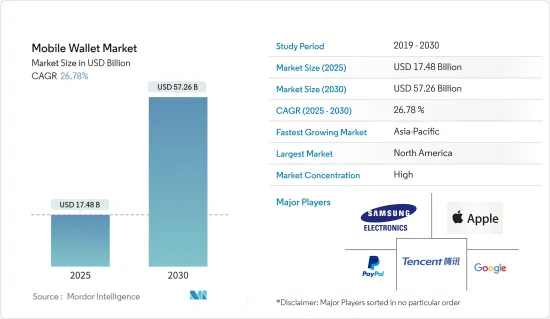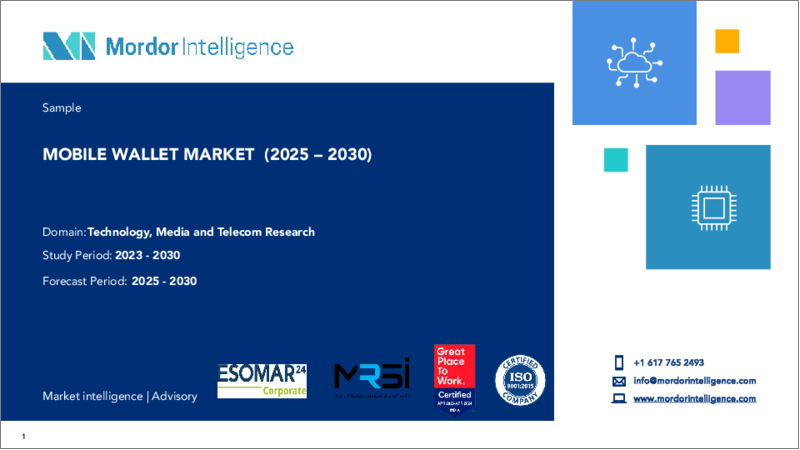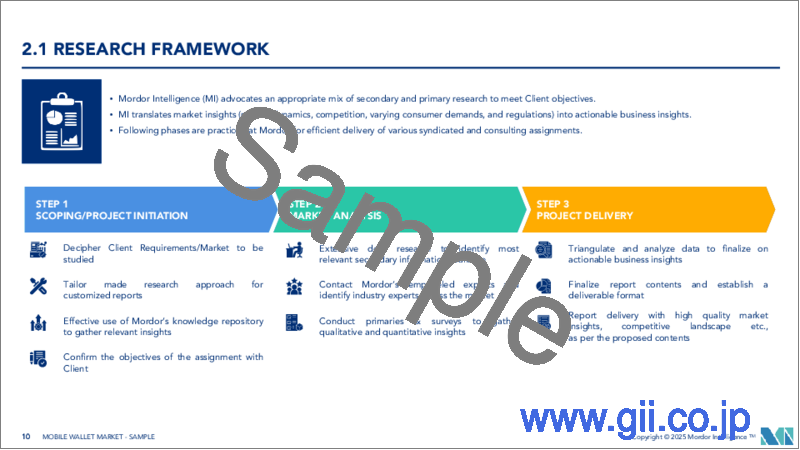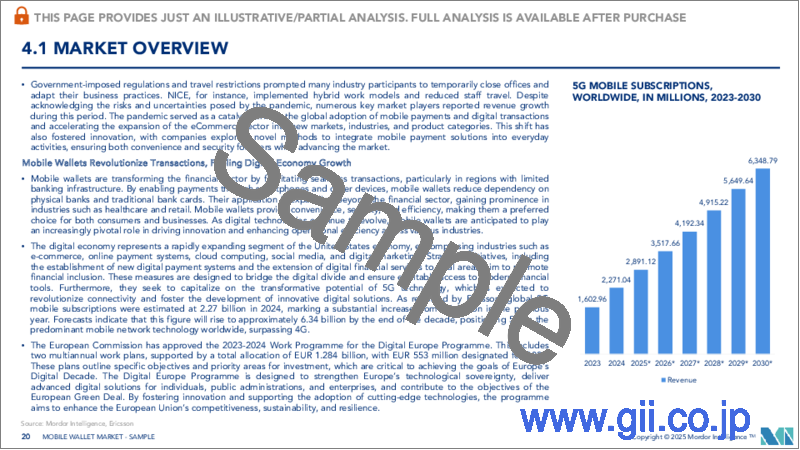|
|
市場調査レポート
商品コード
1642980
モバイルウォレット-市場シェア分析、産業動向・統計、成長予測(2025年~2030年)Mobile Wallet - Market Share Analysis, Industry Trends & Statistics, Growth Forecasts (2025 - 2030) |
||||||
カスタマイズ可能
適宜更新あり
|
|||||||
| モバイルウォレット-市場シェア分析、産業動向・統計、成長予測(2025年~2030年) |
|
出版日: 2025年01月05日
発行: Mordor Intelligence
ページ情報: 英文 120 Pages
納期: 2~3営業日
|
全表示
- 概要
- 目次
モバイルウォレット市場規模は2025年に174億8,000万米ドルと推定され、予測期間(2025~2030年)のCAGRは26.78%で、2030年には572億6,000万米ドルに達すると予測されます。

長年にわたり、現金からデビットカード、オンライン取引へと、決済手段はますます合理化されてきました。さらに、Paypalのようなeコマース手法の登場は、モバイルウォレットの大規模な普及を開始しました。それ以来、デジタルウォレットのコンセプトは進化し、従来の物理的なデジタルウォレットに取って代わるようになりました。最近のCOVID-19の発生により、デジタル決済サービスの利用が増加し、市場は大幅な成長が見込まれています。長年にわたり、スマートフォン産業では、NFC、5Gの採用、生体認証、暗号化、AIなど、提供される機能の面で急速な技術進歩が見られ、ユーザーの日常活動におけるスマートフォンの浸透が進んでいることからも明らかです。これにより、スマートフォンの費用対効果の高さからスマートフォンユーザーの増加の勢いに乗っている金融産業をはじめとするさまざまな産業の成長が促進されています。
主要ハイライト
- さらに、eコマースやmコマースなどのプラットフォームは、ユーザーが銀行情報をそれぞれのウォレットに入力し、クレジットカードやデビットカードに代わる決済手段として携帯電話を利用できるようにすることで、ショッピングなどの金銭取引を行う際のユーザーの習慣を変える上で重要な役割を果たしています。
- 近距離無線通信、音波決済、MST決済はモバイルPOSソリューションの一例で、サービスや販売組織が単一の場所に限定されることなく、柔軟な方法で金銭取引を行うことを可能にします。これは、大手小売店がmPOS技術を採用し、足元の減少をサポートしていることからも明らかなように、加盟店がユーザー体験を向上させながら、屋台や見本市のようなモビリティビジネスを行うことを可能にします。例えば、NFCはApple Pay、Samsung Pay、Google Payのような主要なモバイルウォレットを支える技術を支えています。
- さらに、モバイル決済システムは、スマートウォッチや指輪などのウェアラブル技術の使用により、スマートフォンやタブレットの範囲を超えて拡大しています。ベンダーは現在、取引の安全性を確保し、データプライバシーに関する懸念に対抗するために、ブロックチェーンなどの破壊的技術の可能性を活用しながら、IoTを受け入れています。例えば、Appleはモバイルウォレットを通じて非接触決済、個人間決済、交通系カードなどのサービスを提供し、Appleウォッチと呼ばれるスマートウォッチでApple Payを提供しています。
- 市場はCOVID-19の大流行から恩恵を受けました。政府の法律や渡航制限により、産業参加者はほとんどのオフィスを一時的に閉鎖し、ビジネスプラクティスの変更を余儀なくされました。例えば、NICEはハイブリッド勤務や在宅勤務を採用し、スタッフの出張を制限しました。ほとんどの市場参入企業は、パンデミックが自社にとってのリスクであることを認識し、その影響について確信が持てなかったにもかかわらず、パンデミックの流行期間を通じて収益の増加を経験しました。モバイル決済とデジタル取引は、パンデミックによって世界的に推進されました。パンデミックは、eコマースセグメントの新たな市場、ビジネス、製品カテゴリーへの拡大を加速させました。
モバイルウォレット市場の動向
最も急成長を遂げる近接型決済
- 市場には、NFC、UHF、MST、位置情報決済など、さまざまな近接型決済ベースのモバイルウォレットがあるが、中でも近距離無線通信、QR、磁気セキュアトランスミッションが市場を牽引する主要技術となっています。
- NFCソリューションは、ユーザーが携帯電話を通じて既存の決済カードをシームレスに統合することを可能にし、決済サービスの有効化によって利便性と確実なセキュリティが付加されます。また、トークン化を活用することで、ウェアラブルを介した非接触決済も可能になります。また、自動販売機との統合も可能です。
- また、処理手数料が低いため、小売業者はコストと業務の効率化を達成し、顧客との関係改善に利用できるデータ機会とロイヤルティを得ることができます。例えば、Apple、Google、Samsungなど主要なモバイルウォレット・ベンダーはすべて、自社のモバイルウォレットでNFC技術を利用しています。
- さらに、この動向は若いユーザーの間で技術が普及するにつれて先細りしていくと考えられます。特にZ世代は、消費力を得るにつれて成長を促進すると予想されます。ベビーブーマー世代は、デジタルの総導入数の増加に伴い、モバイルウォレットに引き寄せられ続けると考えられます。
- インドのような新興市場では、ほとんどのスマートフォンにNFC技術は搭載されておらず、代わりにインド国家決済公社(National Payments Corporation of India)がQRコードに基づいて開発した統合決済インターフェース(UPI)に依存しています。
- さらに、Apple Pay、Google Pay、その他の重要なモバイル決済プロバイダーが提供する代替手段のおかげで、デジタルウォレットの受け入れは昨年も間違いなく続きました。デジタルウォレットの誕生は、個人、最近ではあらゆる種類の企業にとって、より優れた、より実用的で摩擦のない決済手続きを提供する上で不可欠なものとなっています。そのため、今年までにデジタルウォレットを使って買い物をするユーザーは世界で44億人に達し、eコマース決済全体の52%を占めると予測されています。さらに、今年中に全世界で16億人の消費者がPOS決済の30%をデジタルウォレットで行うことになります。
アジア太平洋が最速の市場成長を遂げる
- 中国は最近まで、フィンテック企業を活用して国全体でキャッシュレス決済を可能にするなど、常にモバイル経済の主要企業でした。東南アジアは、力強い経済成長とスマートフォンの普及拡大により、上昇傾向にあります。
- また、伝統的に現金に依存してきた経済が、ライドレンタル、送金会社、フィンテックスタートアップ、銀行など、この地域の多くのベンダーを活用し、東南アジアの人々がスマートフォンを通じて電子財布、マイクロローン、インシュアテック製品にアクセスできるようにしています。例えば、Forbesによると、インドネシアは世界で最もモバイルファーストな国のひとつであり、インターネットユーザーの95%がモバイルユーザーであると報告されています。
- Google、Temasek、Bain & Companyのレポートによると、東南アジアのデジタル決済産業は、総取引額が2019年の6,000億米ドルから2025年には1兆1,000億米ドルに成長し、電子財布が2019年に220億米ドル、2025年に1,140億米ドルを占めると予測されています。
- 現在、中国のスマートフォン利用率は59.9%と世界で最も高いです。インドが43.5%で続いています。これらの国では電子財布の利用が広がっています。電子財布は、主にAlipay(Alipay)とウィーチャット(WeChat)という主要企業が推進するモバイルアプリケーションを通じて、暗号化、生体認証、トークン化、デバイス認証を組み合わせ、将来の可能性を再定義しています。
- モバイルコマースやデジタルウォレットの普及に伴い、非接触型決済の受け入れも拡大しています。最近の調査によると、世論調査対象となった3,000人の消費者のうち半数近くが、Starbucks(49%)、McDonald's(43%)、Walmart(41%)の店頭でスマートフォンを使って決済を行っています。ほとんどの非接触型決済は、アプリベースやデジタルウォレット決済ではなく、近距離無線通信(NFC)技術を搭載したハードウェアによって行われます。これには、NFC機能を備えたカードリーダーや携帯電話が含まれます。NFC POS(販売時点情報管理)端末のインフラは小売業者が購入してセットアップする必要があり、NFCと決済データの両方を含むスマートデバイスであるソフト POSシステムにはない追加コストが発生します。
モバイルウォレット産業概要
モバイルウォレット市場は競争が激しく、複数の主要企業で構成されています。市場シェアの面では、現在数社の主要企業が市場を独占しています。突出した市場シェアを持つこれらの大手参入企業は、海外に広がる顧客基盤の拡大に注力しています。これらの企業は、市場シェアと収益性を高めるために、戦略的協業イニシアチブと買収を活用しています。
2022年9月には、Ant Groupが運営するAlipay+と、世界のクロスボーダー決済企業であるThunesが提携し、後者の欧州の顧客や加盟店がアジア企業のモバイルウォレットを通じて決済を受け付けられるようになります。韓国のKakaoPay、マレーシアのTouch'n Go、フィリピンのBoost、中国のAlipayなどが、今回の提携でサポートされるアジアのモバイルウォレットに含まれます。
2022年6月、サウジアラビアを拠点とする大手通信・デジタルサービスプロバイダーであるMobilyと、デジタルP2P決済の最先端を行く世界企業であるMoneyGram International, Inc.との提携により、Mobily PayでMoneyGramの産業をリードする国際送金機能が利用できるようになりました。この提携により、何百万人ものサウジアラビアの消費者がMobily Payのモバイルウォレットを使って即座に国際送金を行うことができます。
その他の特典
- エクセル形式の市場予測(ME)シート
- 3ヶ月間のアナリストサポート
目次
第1章 イントロダクション
- 市場の定義と範囲
- 調査の前提
第2章 調査手法
第3章 エグゼクティブサマリー
第4章 市場洞察
- 市場概要
- 産業の利害関係者分析
- 産業の魅力-ポーターのファイブフォース分析
- 供給企業の交渉力
- 消費者の交渉力
- 新規参入業者の脅威
- 代替品の脅威
- 競争企業間の敵対関係
第5章 市場力学
- 市場促進要因
- スマートフォンと近接型決済の成長
- デジタル変革に向けた政府の取り組み
- eコマースプラットフォームの成長
- 市場抑制要因
- エンドユーザーによるデータプライバシーへの懸念
- COVID-19がモバイルウォレット市場に与える影響
第6章 市場セグメンテーション
- 決済モード
- 近接(NFC、音波ベースの決済、磁気セキュアトランスミッション(MST)決済、クイックレスポンス(QR)コード決済)
- 遠隔決済(インターネット決済、SMS決済、キャリアダイレクト課金、モバイルバンキング)
- アプリケーション
- モバイルコマース
- 送金
- マイクロペイメント
- 小売
- レストラン
- 公共輸送
- 地域
- 北米
- 米国
- カナダ
- 欧州
- ドイツ
- 英国
- フランス
- スペイン
- その他の欧州
- アジア太平洋
- 中国
- 日本
- インド
- オーストラリア
- その他のアジア太平洋
- ラテンアメリカ
- ブラジル
- メキシコ
- アルゼンチン
- その他のラテンアメリカ
- 中東・アフリカ
- アラブ首長国連邦
- サウジアラビア
- 南アフリカ
- その他の中東・アフリカ
- 北米
第7章 競合情勢
- 企業プロファイル
- Apple Inc
- Google Inc
- Tencent Holdings Ltd.
- PayPal Holdings, Inc.
- Samsung Electronics Co., Ltd.
- MasterCard Incorporated
- Visa Inc.
- Ant Financial Services Group
- JP Morgan Chase &Co.
- Mobikwik
- Paytm
- The American Express Company
- First Data Corporation
第8章 投資分析
第9章 市場機会と今後の動向
The Mobile Wallet Market size is estimated at USD 17.48 billion in 2025, and is expected to reach USD 57.26 billion by 2030, at a CAGR of 26.78% during the forecast period (2025-2030).

Over the years, the mode of payment has become increasingly streamlined, from cash to debit cards to online transactions. Additionally, the advent of eCommerce methods such as Paypal has initiated major mobile wallet adoption. Since then, the digital wallet concept has evolved, replacing the traditional physical-digital wallet. With the recent outbreak of COVID-19, the market is expected to witness significant growth owing to an increased usage of digital payment services. Over the years, the smartphone industry has seen rapid technological advancements in terms of features offered, such as NFC, 5G adoption, biometrics, encryption, and AI, among others, which are evident with greater penetration of smartphones in users' daily activities, thereby leveraging the growth of various industries, including the financial industry, which is leveraging the gaining momentum of growing smartphone users owing to the cost-effectiveness of smartphones.
Key Highlights
- Furthermore, platforms such as eCommerce and mCommerce have played a significant role in changing users' habits when performing monetary transactions such as shopping by allowing users to enter their banking information into their respective wallets and enabling mobile phones as a mode of payment in place of credit and debit cards while ensuring security is handled on their side by leveraging technologies such as tokenization and essentially eliminating the risk of being stolen.
- Near-field communication, sound wave payments, and MST payments are examples of mobile-point-of-sale solutions that allow service and sales organizations to conduct monetary transactions in a flexible manner without being limited to a single location.allowing merchants to run mobility businesses such as food trucks and trade shows while improving the user experience, as is evident by major retailers' adoption of mPOS technology to support declining foot traffic. For instance, NFC powers the technology behind major mobile wallets like Apple Pay, Samsung Pay, and Google Pay.
- Additionally, mobile payment systems are expanding beyond the scope of smartphones and tablets with the use of wearable technology such as smartwatches and rings. Vendors are now embracing IoT while leveraging the potential of disruptive technologies such as blockchain to ensure the security of the transaction and counter concerns over data privacy. For instance, Apple Inc. offers services such as contactless payments, person-to-person payments, and transit cards through their mobile wallet and offers Apple Pay on their smartwatch, called the Apple Watch.
- The market benefited from the COVID-19 pandemic. Government laws and travel limitations led industry participants to temporarily close most of their offices, forcing them to alter their business practices. For example, NICE embraced hybrid and work-from-home work arrangements and limited staff travel. Most key market participants experienced increases in revenues throughout the epidemic, even though most acknowledged that the pandemic was a risk to their firm and were unsure of its impact. Mobile payments and digital transactions were propelled globally by the pandemic. It sped up the e-commerce sector's expansion into new markets, businesses, and product categories.
Mobile Wallet Market Trends
Proximity Payments to Witness the Fastest Market Growth
- Although there are various proximity-based, payment-based mobile wallets available in the market, including NFC, UHF, MST, and location-based payments, among others, near-field communication, QR, and magnetic secure transmission are the leading technologies driving the market.
- NFC solutions enable users to seamlessly integrate existing payment cards through mobile phones, and the activation of payment services adds convenience and assured security. Even so, it makes contactless payments via wearables by leveraging tokenization. Also, it integrates with vending machines.
- Also, its low processing fees will help retailers achieve cost and operational efficiency and obtain data opportunities and loyalty, which could be used to improve customer relations. For instance, all the major mobile wallet vendors, such as Apple Inc., Google LLC, and Samsung Corporation, utilize NFC technology on their mobile wallets.
- Further, the trend will taper off as technology spreads among younger users. Gen Z, in particular, is expected to fuel growth as it obtains spending power. Baby boomers will continue to gravitate toward mobile wallets in tandem with increases in total digital adoption, partly due to the pandemic and partially because younger family members are encouraging them to do so.
- In an emerging market such as India, most smartphones do not come equipped with NFC technology, and people instead rely on the Unified Payment Interface (UPI) developed by the National Payments Corporation of India based on QR codes.
- Additionally, the acceptance of digital wallets continued undoubtedly in the last year, thanks to the alternatives that Apple Pay, Google Pay, and other critical mobile payment providers offered. The creation of digital wallets has been essential in providing a better, more practical, and frictionless payment procedure for individuals and, increasingly, businesses of all sorts. Accordingly, it is predicted that by the current year, 4.4 billion users worldwide will shop using a digital wallet, making up 52% of all e-commerce payments. Additionally, 1.6 billion consumers worldwide will make 30 percent of all POS payments using digital wallets in the current year.
Asia-Pacific to Witness the Fastest Market Growth
- China has always been a major player in the mobile economy, leveraging its fintech firms to enable cashless payments across the country until recently. Southeast Asia is on the rise, owing to its strong economic growth and increased smartphone penetration.
- Also, the traditionally cash-reliant economy is leveraging the host of vendors in the region, such as ride-rentals, remittance firms, fintech startups, and banks, to provide people in Southeast Asia greater access to e-wallets, microloans, and insurtech products through smartphones. For instance, according to Forbes, Indonesia is one of the most mobile-first countries in the world, with 95% of internet users reported as mobile users.
- According to a Google, Temasek, and Bain & Company report, the Southeast Asia digital payment industry is projected to grow the gross transaction volume from USD 600 billion in 2019 to USD 1.1 trillion by 2025, with e-wallets sharing USD 22 billion in 2019 and USD 114 billion in 2025.
- At 59.9%, China now has the highest smartphone usage rate worldwide. India follows with a 43.5% utilization rate. The use of e-wallets is widespread in these nations. They are currently at the forefront of the payment revolution by providing security and convenience for payment processing. eWallets combine encryption, biometrics, tokenization, and device authentication via mobile applications, primarily driven by key players Alipay and WeChat, redefining the future's potential.
- Contactless payments are growing in acceptance as mobile commerce and digital wallets become more common. According to a recent study, nearly half of the 3,000 consumers polled used their smartphones to pay in-store at Starbucks (49%), McDonald's (43%), and Walmart (41%). Most contactless payments will be powered by hardware equipped with near-field communication (NFC) technology instead of app-based or digital wallet transactions. This includes card readers and cell phones with NFC capabilities. The infrastructure for NFC point-of-sale (POS) terminals must be purchased and set up by retailers, which incurs additional costs not present in soft POS systems, which are smart devices that contain both NFC and payment data.
Mobile Wallet Industry Overview
The mobile wallet market is highly competitive and consists of several major players. In terms of market share, a few major players currently dominate the market. These major players with a prominent market share focus on expanding their customer base across foreign countries. These companies leverage strategic collaborative initiatives and acquisitions to increase their market share and profitability.
In September 2022, Alipay+, run by Ant Group, and Thunes, a global cross-border payments company, will join forces to allow the latter's European customers and merchants to accept payments through Asian companies' mobile wallets. KakaoPay in South Korea, Touch 'n Go in Malaysia, Boost in the Philippines, and Alipay in China are among the Asian mobile wallets that will be supported by the collaboration.Additionally included are the Thai services Rabbit, LINE Pay, and TrueMoney.
In June 2022, A partnership between leading Saudi-based telecommunications and digital service provider Mobily and MoneyGram International, Inc., a global company at the forefront of digital P2P payments, enabled the launch of MoneyGram's industry-leading international money transfer capabilities on Mobily Pay. Through this partnership, millions of Saudi Arabian consumers would instantly send money internationally using the Mobily Pay mobile wallet.
Additional Benefits:
- The market estimate (ME) sheet in Excel format
- 3 months of analyst support
TABLE OF CONTENTS
1 INTRODUCTION
- 1.1 Market Definition and Scope
- 1.2 Study Assumptions
2 RESEARCH METHODOLOGY
3 EXECUTIVE SUMMARY
4 MARKET INSIGHTS
- 4.1 Market Overview
- 4.2 Industry Stakeholder Analysis
- 4.3 Industry Attractiveness - Porter's Five Forces Analysis
- 4.3.1 Bargaining Power of Suppliers
- 4.3.2 Bargaining Power of Consumers
- 4.3.3 Threat of New Entrants
- 4.3.4 Threat of Substitute Products
- 4.3.5 Intensity of Competitive Rivalry
5 MARKET DYNAMICS
- 5.1 Market Drivers
- 5.1.1 Growth of smartphone and proximity payment
- 5.1.2 Government initiative towards digital transformation
- 5.1.3 Growth of e-commerce platforms
- 5.2 Market Restraints
- 5.2.1 Data Privacy concerns by end-users
- 5.3 Impact of COVID-19 on Mobile wallet Market
6 MARKET SEGMENTATION
- 6.1 Mode of Payment
- 6.1.1 Proximity ( NFC,Sound waves-based payments,Magnetic secure transmission (MST) payments,Quick response (QR) code payments)
- 6.1.2 Remote Payment (Internet payments,SMS payments,Direct carrier billing,Mobile banking)
- 6.2 Application
- 6.2.1 Mobile Commerce
- 6.2.2 Money Transfer
- 6.2.3 Micropayment
- 6.2.4 Retail
- 6.2.5 Restaurant
- 6.2.6 Public Transport
- 6.3 Geography
- 6.3.1 North America
- 6.3.1.1 United States
- 6.3.1.2 Canada
- 6.3.2 Europe
- 6.3.2.1 Germany
- 6.3.2.2 UK
- 6.3.2.3 France
- 6.3.2.4 Spain
- 6.3.2.5 Rest of Europe
- 6.3.3 Asia-Pacific
- 6.3.3.1 China
- 6.3.3.2 Japan
- 6.3.3.3 India
- 6.3.3.4 Australia
- 6.3.3.5 Rest of Asia-Pacific
- 6.3.4 Latin America
- 6.3.4.1 Brazil
- 6.3.4.2 Mexico
- 6.3.4.3 Argentina
- 6.3.4.4 Rest of Latin America
- 6.3.5 Middle East and Africa
- 6.3.5.1 UAE
- 6.3.5.2 Saudi Arabia
- 6.3.5.3 South Africa
- 6.3.5.4 Rest of Middle East and Africa
- 6.3.1 North America
7 COMPETITIVE LANDSCAPE
- 7.1 Company Profiles
- 7.1.1 Apple Inc
- 7.1.2 Google Inc
- 7.1.3 Tencent Holdings Ltd.
- 7.1.4 PayPal Holdings, Inc.
- 7.1.5 Samsung Electronics Co., Ltd.
- 7.1.6 MasterCard Incorporated
- 7.1.7 Visa Inc.
- 7.1.8 Ant Financial Services Group
- 7.1.9 JP Morgan Chase &Co.
- 7.1.10 Mobikwik
- 7.1.11 Paytm
- 7.1.12 The American Express Company
- 7.1.13 First Data Corporation





